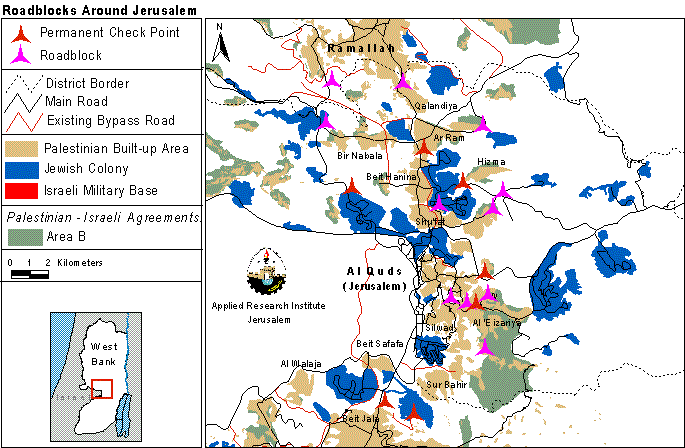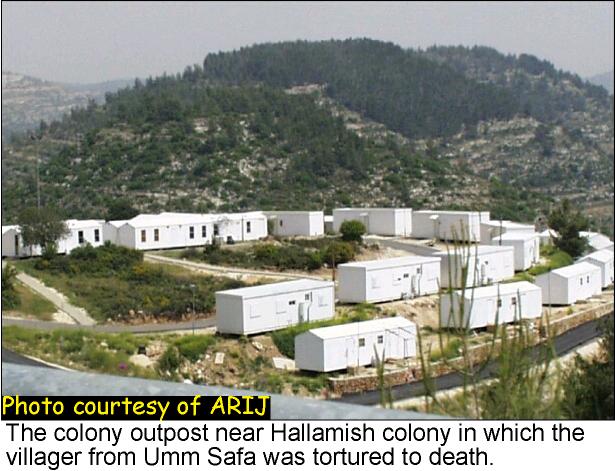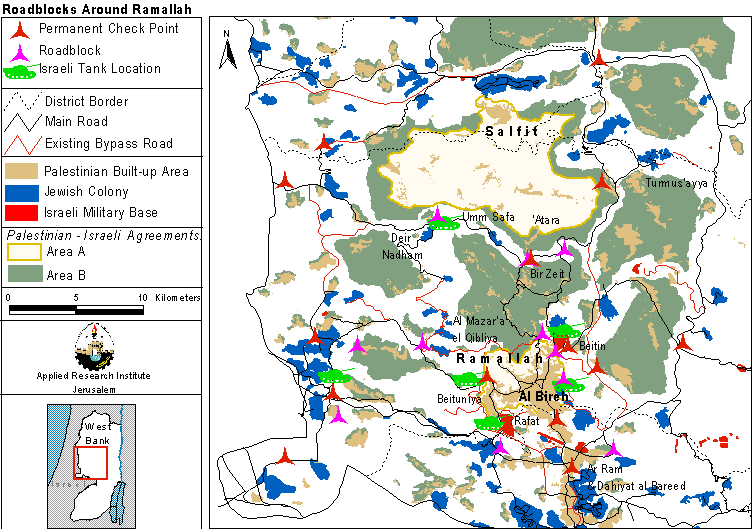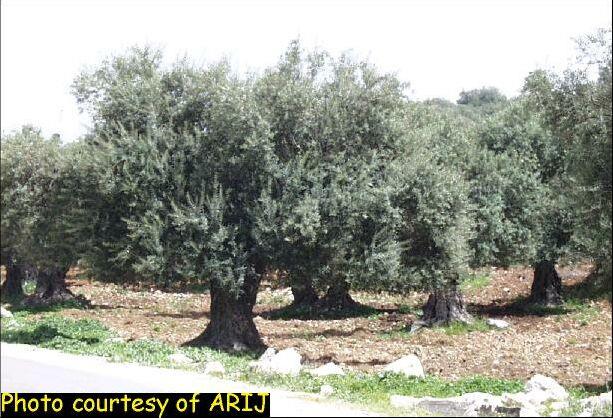The districts of Jerusalem and Ramallah lie in the center of the West Bank. These two districts house about one third of the West Bank's population and play a central role in the daily life of Palestinians. Jerusalem has been a focal point in the Palestinian political struggle as the capital of the Palestinian State and it is also important to the two major religions in Palestine; Islam and Christianity. However, ever since Israel occupied it in 1967, it has made the dissociation of Jerusalem from Palestinian life a primary goal (click for more).
Therefore, Ramallah has acquired a de facto centrality by acting as an interim capital. A major part of the Palestinian public sector, as well as the private sector, is centered in Ramallah. Moreover, three of the top universities in Palestine are in those two districts and thus they attract a sizeable portion of Palestine's academic activity. And finally, this centrality has meant that non-governmental organizations, as well as international organizations, have established their headquarters in these two districts. In sum, Jerusalem and Ramallah form the heart of the West Bank.
In the early 1990s Israel adopted the closure policy and started putting checkpoints around the West Bank and around Jerusalem (see map). According to this policy Palestinians were required to have permits in order to pass into or through Jerusalem. It was a way to screen Palestinians moving in and out of those areas and to keep them away whenever the Israeli authorities desired.
With the outbreak of the Al-Aqsa Intifada Israel proceeded with forming tighter closures on Jerusalem on top of putting roadblocks around Ramallah too. In Jerusalem, people under the age of 45 were barred from attending the Friday prayers in Al-Aqsa mosque. In fact, they were also barred from entering the Old City. Mass arrests of youth in the villages surrounding Jerusalem meant that many young Palestinians could not move freely without fear of being detained.
Furthermore, settlers went on a rampage of Palestinian neighborhoods in Jerusalem. There were several attacks by mobs of settlers that chanted anti-Arab slogans and many Palestinian houses and cars suffered damages. Many Palestinian employees, who reside in various parts of the West Bank while working in Jerusalem, have had difficulties reaching their places of employment if they were able to get there at all. So institutions have had to manage their work with a diminished staff. The blockade on Jerusalem has cut off the center of the West Bank from its natural hinterland; see map. .
As mentioned earlier, Ramallah houses the main offices of the public sector. The blockade has prevented many employees of the public sector from reaching their offices. The transport of certain goods has also suffered delays and obstruction. Businesses in Ramallah are beginning to run out of stocks while their financial obligations pile up. The Palestinian villages of Atarah (1662 inhabitants), Bit Sera (2010 inhabitants), and Umm Safa (510 inhabitants) have been cut off from the other villages of the Ramallah district since their sole entrances have been blockaded by the Israeli army; see map. Israeli occupation forces besieged Bit Sera for seven consecutive days. They also closed the entrances to and from the villages, and prevented the students and workers from reaching their schools, universities andworks. The village of Umm Safa was witness to a brutal murder when one of its residents was abducted by the Israeli army and then handed to Jewish settlers that tortured him to death; . Israeli occupation forces besieged Bit Sera for seven consecutive days. They also closed the entrances to and from the villages, and prevented the students and workers from reaching their schools, universities andworksThe village of Umm Safa was witness to a brutal murder when one of its residents was abducted by the Israeli army and then handed to Jewish settlers that tortured him to death; see photo1, photo2. Atarah village, which lies just north of Bir Zeit, has only one entrance that the Israeli army controls. The blockade has also affected the season of picking of olives. Villagers from El Mazra'a El Qibliya (3003 inhabitants), Turmus Aya (3147 inhabitants), and Deir Nadham (643 inhabitants) have had difficulty reaching their olive fields from which they get their bi-yearly supply of olives and olive oil. Some of the olives are sold in the market so the blockade has had and economic effect on the villagers; . Atarah village, which lies just north of Bir Zeit, has only one entrance that the Israeli army controls. The blockade has also affected the season of picking of olives. Villagers from El Mazra'a El Qibliya (3003 inhabitants), Turmus Aya (3147 inhabitants), and Deir Nadham (643 inhabitants) have had difficulty reaching their olive fields from which they get their bi-yearly supply of olives and olive oil. Some of the olives are sold in the market so the blockade has had and economic effect on the villagers; see map.
The goal behind the blockade is to enforce a de facto annexation of the areas under Israeli control in the West Bank and Gaza. Israeli policy makers have repeatedly threatened to do so in case the Palestinians tried to unilaterally declare independence. As the maps show, the Israelis have a firm grip over Jerusalem and Ramallah, the heart of the West Bank and the continued blockade will adversely affect the Palestinians in all aspects of their lives.
Prepared by:
The Applied Research Institute – Jerusalem

















